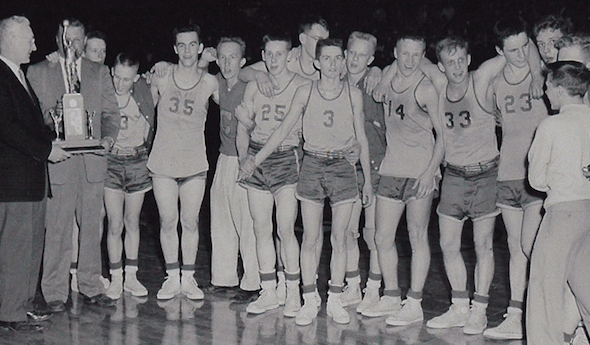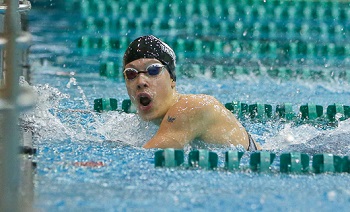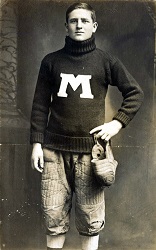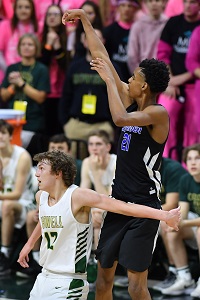
60 Years Later, Chassell Streak Stands
March 22, 2016
Sixty years ago, something happened in Michigan high school boys basketball that hadn’t happened before and hasn’t happened since – three Upper Peninsula teams won titles. Stephenson beat Detroit St. Andrew, 73-71 in overtime when “Marvelous” Mel Peterson made the first basket of sudden death; Crystal Falls (before it was called Forest Park) beat Berrien Springs, 71-69, in Class C; and Chassell won the first of three straight Class D titles, beating Portland St. Patrick, 71-68, by rallying from a 15-point deficit with less than four minutes to play.
The win was part of Chassell’s state record 65-game winning streak, which still stands. Below is an excerpt of a piece on the Chassell streak written before the teams were honored as part of the “Legends of the Games” program at the 1998 Boys Basketball Finals.
The old adage in sports states that records are made to be broken. The longer, however, the record stands, the more legendary the accomplishment becomes.
Chassell's wins were the centerpiece of Upper Peninsula success in the MHSAA Boys Basketball Tournament during the first 11 years after the format unified the two peninsulas. From 1932 to 1947, separate finals were conducted in both peninsulas. Between 1948 and 1958, Upper Peninsula schools won three Class B crowns (there were no Class A schools in the U.P. at the time), two Class C titles, and seven Class D championships – over one-third of the available first-place finishes.
Wrote the Marquette Mining Journal in 1956, the year that Stephenson in Class B, Crystal Falls in Class C and Chassell in Class D all won MHSAA titles, "All of these is a startling figure since in the period the U.P. has only 42 (schools) -- one eighth of all the lower class quarterfinalists.
"Under the law of averages, the U.P. should come up with one state champ every three years."
It looked at first that the law of averages would catch up with Chassell. After starting the 1955-56 season with 11 straight wins, the Panthers lost a close January game at Trout Creek, and then won their way downstate into the finals against Portland St. Patrick. In that final game, St. Patrick held a 15-point lead at 68-53 with less than four minutes to play.
Coach Ed Helakoski, the architect of the Chassell winning streak, called time out and told his team to apply full court pressure, a rarity at the high school level at that time.
Playing without standouts Terry Pokela and Tom Peters, who had fouled out, Chassell scored the final 18 points of the contest, the biggest game-ending rally in Finals history, and won the first crown, 71-68. Sophomore guard Don Mattson scored the winning points with only seconds to play, finished the game with a finals record 25 points, and the Panthers finished the season 25-1 with 14 consecutive victories.
During the 25-0 run to the crown in 1956-57, the only close games were regular-season wins against National Mine (71-66), L'Anse (64-63), Doelle (73-69), and a 58-50 decision over Stevensville in the championship game at Jenison Fieldhouse. Of the other 21 games, none were closer than 13 points, and the average margin of victory was 27 points.
The winning streak stood at 39 entering the 1957-58 season, and the 10-year state record of 59 consecutive victories by Mass from 1947-49 was within reach. However, Mattson was the only returning starter from the back-to-back championship teams, and perhaps Helakoski's greatest coaching job lay ahead to replace four starters in a school which had just over 30 boys enrolled in grades 9-12.
Doelle, which had given the Panthers one of its closest games the season before, was leading, 62-60, in an early-season contest. As time ran out, Bob Belhummer of Chassell was fouled at midcourt and sent to the free throw line with a one-and-one opportunity. Belhummer sank both shots to force the only overtime game of the streak, a 72-66 victory.
The new state record of 60 consecutive victories came in a 45-43 decision over Marenisco in the MHSAA District championship game. A trip over the newly-constructed Mackinaw Bridge came two weeks later and the Panthers became the first school to bring an MHSAA trophy across the structure when the 65th victory was recorded, a 66-61 decision over Owosso St. Paul. Mattson tallied 27 points in the finale to set another championship game record.
In the 40 years since Chassell's incredible feat, only twice has the winning streak been threatened. Flint Northwestern racked up 60 victories between January of 1984 and February of 1986; and Saginaw Buena Vista had a streak reach 55 games between December of 1991 and December of 1993.
In many communities, success streaks come and go, but a constant ideal of school sports then and today was captured by John Pyykkonen, a guard and forward on the 1956 and 1957 teams who summarized the events: "I remember the friendly competition amongst the members of the team and how well we worked together and how our parents, fans and the community were behind us 100 percent of the way. One of the greatest highlights in a young man's life and will never be forgotten."
Records were made to be broken. But legends, especially Legends of the Games like Chassell, endure the test of time.
GLORY DAYS ... Remembering The Streak
John Pyykkonen - 1956-57 Guard-Forward: "One thing I remember clearly, besides the games, is walking into Jenison Fieldhouse and being totally awestruck by the raised floor and the huge (in my eyes) guides who showed us around the building. I recall the game in 1956 when we were so far behind in points and we were able to overcome the point deficit by a full court press. The huge crowd gathered there were all cheering for the small-town team."
Robert Belhumer - 1956-1957-1958 Guard: "We had a great camaraderie among the members of our team. Also Chassell is a small town in the Upper Peninsula and the fans were there rooting for us during our seasonal games and were there for us at the championship games in Lansing."
Donald Jaakkola - 1956 Guard (On the championship game): "We ran out onto the court to a crowd of 12,000 people, most of whom were cheering for Portland St. Patrick. Needless to say, we felt a bit in awe as we came from Chassell, a small town in the Upper Peninsula.
"We were down 15 points with four minutes to go and two of our tallest players had fouled out earlier. Coach Ed Helakoski called a timeout and the basketball gods were with us. We threw a full court press defense and scored 18 points while holding St. Patrick scoreless. It gave us a screaming 71 to 68 victory. The crowd of 12,000 was now cheering for us."
Mike Wisti - 1956 Guard (On Coach Ed Helakoski): “I am quite sure there are many who will remember Ed Helakoski as a good coach. I'm sure he was a good coach; he had a knack for demanding discipline and teamwork, while not stifling the creativity of his players. However, I believe he should also be remembered as a great classroom teacher. He taught Government one year and Sociology the next and was the best classroom teacher that I had in high school. His ability to make Government interesting and explain how everything was designed to work is probably one of the biggest reasons for my lifelong interest in government and politics."
Kenneth Tormala - 1956-1957-1958 Forward: "The first year we surprised a lot of teams and people by winning the state championship. The second year we were picked to win when the year started and it would have been a real disappointment not to have done so. The third year was a real challenge since we lost so many players, but we had the backbone of the team, Don Mattson, who was an all-stater. This team was the most closely knit of all. We had a lot of very close games and had to dig down to everything we had learned to win many of them. A very satisfying year and we kept the winning streak going, to the surprise of many, including the previous teams.
"These memories will be fondly remembered until we die. Thank you to the late Mr. Helakoski."
James Komula, 1958 Guard (On what stands out from that season): "Being from a small town and playing in small gyms, the spaciousness and large crowd in Jenison Fieldhouse proved very exciting. Also, the reception and festivities upon our triumphant return to Chassell will forever be a highlight of personal memories. People were waiting in their vehicles nearly 30 miles from town to accompany our motorcade home.
"Although I didn't give it much thought, the experience and influence of playing on that team would set the direction for my career. Upon graduation from Michigan Tech, I was given an interim position to teach and coach at L'Anse High School. In 1966, I was assistant coach when L'Anse won the Class C state championship. After that I moved to Livonia, where in later years I was head coach at Bentley High School. Although I never intended, my high school basketball did influence my career to work with youngsters, and help them share in the rewards of the commitment and lifelong learning of athletics."
Terry Pokela, 1956-1957 Center: "We truly had a team. Coach Helakoski did not allow us to think of individual statistics or anything like that. He constantly emphasized the team concept. It certainly paid off.
"Also, we were one of the first teams to fast break after every missed shot by opponents. Our three-lane break broke many team's backs, as they couldn't keep up with us. Coach Helakoski emphasized rebounding position to enable the fast break to get started. We could also shoot field goals from any part of the court. Don Mattson would have scored 40 points a game if the three-point field goal would have been in effect."

2018-19 Stacking Up With Best on Records
March 29, 2019
By Ron Pesch
Special for Second Half
What a sports year.
There certainly have been some amazing athletic feats over the 2018-19 high school season in Michigan, and it’s just two-thirds of the way complete.
This past fall, Kobe Clark of Schoolcraft scored nine touchdowns in a single game. Stunning!
The winter sports season saw Dylan Jergens of Marcellus Howardsville Christian top the MHSAA single season scoring record in boys basketball, finishing with 971 points. Incredible!
Then a freshman, Emoni Bates, hits for 31 points in an MHSAA Semifinal for Ypsilanti Lincoln. Wow!
So, how does that compare to years past?
First, let’s hit the pool!
SWIMMING
Across the world, as well as in Michigan, record performances seem to fall regularly in swimming. I’m certainly no expert on the sport, but research seems to indicate that optimization of stroke count, kicks and other body positioning (and not a change in the density of H2O) impact the lowering of recorded times in the water. The continued synchronization and optimization of movement may mean we’ll see regular improvement for years to come.
It’s telling that MHSAA all class/division records in eight of the 12 events that make up a girls meet have been set this decade. The remaining four marks date to 2002 or 2007, and are held by Kara Lynn Joyce of Ann Arbor Pioneer or Allison Schmitt of Canton. Joyce, of course, went on to post 18 NCAA championships and four silver medals won during three Olympic competitions. A freestyle specialist, Schmitt won eight Olympic medals across the 2008, 2012 and 2016 games.
 This past fall, the triumphs of three athletes, in particular, stand out. Kathryn Ackerman set a new state mark in the 200 individual medley with a time of 1:57:25. A junior, Ackerman’s time should place nationally in the top 15 all-time. With the 2018 season complete, she now holds the top four times in the event according to the MHSAA record book.
This past fall, the triumphs of three athletes, in particular, stand out. Kathryn Ackerman set a new state mark in the 200 individual medley with a time of 1:57:25. A junior, Ackerman’s time should place nationally in the top 15 all-time. With the 2018 season complete, she now holds the top four times in the event according to the MHSAA record book.
Senior Ashley Turak sprinted to a new Division I record of 22.10 in the 50 freestyle for Harrison/Farmington on the first leg of the 200 freestyle relay, as well as a time of 22.20 in the 50 freestyle. Both those times also rank in the national record books within the top 15. The MHSAA All-Class/Division Final Meet mark still belongs to Joyce, who posted a time of 22.04, set while leading off the 200 freestyle relay team in the Class A 2002 preliminaries.
Turak again mesmerized the crowd, this time in the 100-yard freestyle, posting a time of 48.72 seconds to win the event. Again, Joyce holds the Michigan All-Class/Division mark with a then-national record time of 48:59 set in 2002.
This November, Grand Ledge junior Lola Mull fell less than a half-second short of her own state mark in the 500-yard freestyle, set in the 2017 preliminaries. Mull owns the state’s top three times in the event, while Schmitt ranks fourth on the list.
Sub 20
A winter sport in Michigan, boys swimming is no different, with records in 10 of the 12 events set in the 2010s. Cam Peel of Spring Lake became the first in state history to break 20 seconds in the 50-yard freestyle, accomplishing the milestone twice this March, first in the prelim race with a record time of 19.86 and again in the finals at 19.91. The marks surpassed the previous best, set by Henry Schutte of Grand Rapids Forest Hills Central one year ago, and also rank among the “Best of the Best” in the National Federation record book.
FOOTBALL
Clark’s nine touchdowns came in Schoolcraft’s 63-27 victory over previously undefeated Constantine in a Southwestern Athletic Conference contest. Thanks to steady rain in the first half, Schoolcraft stuck to the ground game, opening a 21-0 first quarter lead on three Clark touchdowns, one of eight yards, the second of 24, and the third of 10 yards. Constantine battled back to within eight points, 21-13 late in the second quarter, but Clark would score for Schoolcraft twice more during the final three minutes before halftime.
 Following a 24-yard scamper, a partially blocked punt would set up Clark’s fifth rushing TD from two yards out with under a minute remaining before the break. (This appears to be a great moment to note that five players have scored five touchdowns in a single quarter). Clark added two TDs in the third quarter and two in the fourth.
Following a 24-yard scamper, a partially blocked punt would set up Clark’s fifth rushing TD from two yards out with under a minute remaining before the break. (This appears to be a great moment to note that five players have scored five touchdowns in a single quarter). Clark added two TDs in the third quarter and two in the fourth.
Amazingly, Clark’s nine touchdowns and 54 points scored are not state records. In fact, two others have matched the touchdown and point count, while three others have exceeded the accomplishment in each category. Of course, each of those events occurred at least 90 years ago, decades before the introduction of the mercy rule in high school football.
For many years, Herb Dunphy was listed as the state’s record holder for a pair of seemingly untouchable records: touchdowns in a single game and points scored in a game. In 1917 he scored 10 TDs for Lansing Central and stood alone at the top.
But as time has proven again and again, the work of historians and researchers can alter what we believe. In 1986, research by Tom Pellow of Gwinn uncovered that Marmaduke “Duke” Christie of Escanaba had also scored 10 touchdowns, matching Dunphy’s output. In addition, Christie added six point-after-touchdowns that day, totaling 66 points, as Escanaba defeated Ishpeming 102-0 in November 1920.
“In my humble opinion, Escanaba high school in 1920 had one of the greatest football teams that ever misunderstood a signal in any language,” wrote Cy DeLynes, recalling the exploits of Christie and his teammates in the Escanaba Daily Press in 1929. “Christie was its captain. The Duke had a pair of collapsible ankles and he was able to play in only a part of four games. That, however, was just enough time to permit him to score 21 touchdowns and 38 out of a possible 50 points after touchdown – a total of 164 points. He led a backfield that made Knute Rockne’s Four Horsemen look like a quartet of super-annuated milk wagon drivers turning off the alarm clocks at 4 o’clock in the morning.”
A few years later, additional study of yearbooks and newspapers revealed the exploits of Cecil Hardy of Flint Central, again reshaping the scoring entries in the MHSAA record book.
In the 1914 season opener – a 106-0 blasting of Lapeer – Hardy carried for more than 300 yards. Within the first two minutes of play, the captain of the Flint squad had scored the first of 11 touchdowns – a “new” state mark.
“His end running was the feature of the game, his longest run being one for 50 yards and a touchdown on the first play after the kickoff. Time after time as he was making his long runs he appeared to be tackled and would wriggle out of the grasp of his opponent and run 15 or 20 yards further,” was the report of the day.
“How Is This For Football?”
Muskegon 216, Hastings 0
The Boston Globe paired the question with the football score from a Michigan high school game to readers in their Sunday edition back on September 29, 1912.
“Most of Muskegon’s touchdowns were scored on the kick-off,” stated the Globe, “and few required more than one down.”
The score was believed to be a “world’s record” for points scored in a game, at the time. Indeed, the total ranks as the tops in Michigan. Indeed, it was a record nationally, but would be surpassed on three occasions in the coming years, first in 1923, again in 1924 and finally in 1927. With today’s employment of the running clock, the scoring totals will never again be approached.
The score was 40-0 at the end of the first quarter, 102-0 following the second, and 150-0 after three quarters. Touchdowns were scored by nine different players, with six scoring multiple times. As byproducts, captain Fred Jacks finished with nine touchdowns, while Muskegon’s Nelson Stuit booted 24 of 30 extra points in the contest (another state mark that also will never be equaled).
“Although world’s records fell in the game it is not anything to be particularly proud of …” stated the Muskegon Chronicle in the prose of the time. “The visitors had about three men that knew a football from an eff, and those three could not make the Muskegon second team.”
One of the best, as it turned out, was Fred Rehor, Hastings’ “big 220 pound fullback” who would later play for Michigan, then professional ball in Ohio for the 1917 Massillon Tigers, coached by Knute Rockne.
 As a result of the Muskegon-Hastings game, “at least three of the football elevens which contracted this year to meet Muskegon high school have begun to make excuses in line with those usually offered before a team quits such an engagement,” wrote the Lansing State Journal. Muskegon rolled up 499 points on the year, but ended a flawless season in defeat, 13-12 against rival Grand Rapids Central in the finale. The loss was blamed on overconfidence.
As a result of the Muskegon-Hastings game, “at least three of the football elevens which contracted this year to meet Muskegon high school have begun to make excuses in line with those usually offered before a team quits such an engagement,” wrote the Lansing State Journal. Muskegon rolled up 499 points on the year, but ended a flawless season in defeat, 13-12 against rival Grand Rapids Central in the finale. The loss was blamed on overconfidence.
The aptly named Francis Tallent of Menominee, became the next player to score nine TDs in a game.
Tallent’s skills on the gridiron had been spotted in 1928.
“Standing out like a missing tooth in a front row of the chorus … (Tallent) revealed as speedy a pair of heels as one could ever hope to cast his optics on in a high school game,” wrote one reporter after witnessing the left halfback’s performance in the annual twin cities battle between Menominee and Marinette, Wis., then played on Armistice day. Tallent scored twice in that “M & M” game, a 26-0 win by Menominee.
After thumping Green Bay in its 1929 season opener and a “helpless” Oshkosh Normal (now known as the University of Wisconsin-Oshkosh) freshmen team, 46-6, Menominee squared off for its game against “a light and green squad” from Kingsford.
According to the Milwaukee Journal Sentinel, Tallent scored nine touchdowns that day on runs of 46, 72, 90, 64, 50, 37, 90, 85 and 63 yards. In total, the paper noted that Tallent gained 597 yards rushing in the 150-0 thrashing of Kingsford. Other sources noted that it was likely more, as the sum of only the TD runs equaled the 597 yard total. Kingsford would finish its seven-game season without scoring a point. According to the Kingsfordian, the school’s high school annual, the Kingsford players “were no match for the heavier and more experienced teams on the range” that school year.
Menominee’s success and Tallent’s football exploits prompted the Journal-Sentinel to send a reporter to the U.P. to cover the 1929 M & M game between the border schools later that fall. “Mr. Tallent, who runs like the well-known hare and who slips out of tacklers’ arms and hands like a piece of wet soap, scored four touchdowns in the course of the afternoon,” wrote the staffer. “All told, this Mr. Tallent rolled up 284 yards,” as the “pride of the peninsula walloped Marinette,” 49-0, before a crowd of 10,000. The score was “the highest ever piled up in 45 years of bitter rivalry between the two cities.”
Menominee ended the 1929 season undefeated and untied in eight games, scoring over a point-a-minute while claiming the Upper Peninsula championship and demanding statewide consideration for Michigan’s mythical crown. Tallent finished the season with 27 touchdowns.
BASKETBALL
After 35 years, one began to wonder if Mark Brown’s single-season scoring mark, set in 1984-85 during his days at Hastings, would ever be surpassed. Brad Redford, named Michigan’s Mr. Basketball, came close as a senior in 2007-08, falling 17 points shy of exceeding Brown’s total of 969. Prior to that, only Drew Neitzel of Wyoming Park had come within reasonable striking distance, but that happened a decade and a half ago.
This year, Jergens of Howardsville Christian finally topped the total, finishing with 971 points. Jergens accomplished the task in 24 games, two games fewer than Brown, but with the advantage of the 3-point shot. The three was implemented after Brown had headed to college. According to press reports, Jergens had four games of at least 50 points during the season.
Still standing, 40 years later, is Jay Smith’s high school career scoring mark of 2,841 points, set at Mio between 1976 and 1979. Jergens finished third on the list with 2,782 career points, including 320 career 3-pointers – second most in state history. Brown ranks second with 2,789 points scored between 1982 and 1985.
 Freshmen
Freshmen
Few followers of prep basketball in Michigan could avoid coming across the name Emoni Bates, especially after the freshman phenom from Ypsilanti Lincoln knocked down 17 points in the Quarterfinals, 31 points in the Semifinal round of the Division 1 tournament, then 23 in the championship game. The immediate question on press row was, “Had another ninth grader ever exceeded his totals in a MHSAA final-rounds contests?” There was nothing to exceed it that I could recall.
While we’ve kept final round records, including single-game scoring marks, the website minimum is 40 points, and we’ve never captured a list that’s broken down by year in school.
So, I decided to dig.
Quarterfinals
The state has certainly seen some talented freshmen pass through the last rounds of the tournament. Monte Morris scored 20 points in the Quarterfinals for Flint Beecher during its Class C run in 2010. Saginaw Buena Vista played two freshmen, Mark Macon and Shawn Randolph, along its route to the Finals in 1984. Macon, at the age of 14, scored 22 points in a Quarterfinal win over Menominee that season. Two players scored 24 points in the quarters as freshmen: Flint Beecher’s Roy Marble, Jr. in 1982 in a loss to Okemos and Manton’s Matt Stuck, who scored 24 in defeat against Mio in 1989. But, according to Detroit Free Press accounts, it appears Michael Payton from Detroit St. Leo is the leading freshman point-getter in the Quarterfinal round. Payton netted 26 in a 74-62 loss to Flint St. Redeemer in the 1970 tournament.
Semifinals
Macon in 1984 and perhaps the most famous of freshmen in MHSAA Tournament history, Willie Betts of River Rouge in 1961, both scored 14 in Semifinal victories. Clyde Corley from Pontiac Central tossed in 16 points during a heartbreaking Semifinal defeat, 53-52, to Saginaw in 1976. Kelvin Torbert posted 17 points (and 10 rebounds) in a 65-62 Semifinal loss to Belleville in 1998. Morris tallied 18 in a loss to Melvindale Academy for Business & Technology in the Class C semis in 2010. So, Bates’ total of 31 certainly appears to top the list.
Finals
Only one freshman prior to Bates has hit for double digits in a state final. In 1992, Saginaw Buena Vista’s Terrance Roberson went 3 for 7 from the field and 4 for 7 from the free throw line to finish with 10 points as the Knights grabbed a 54-44 win over Grandville Calvin Christian.
Please, let me know if I missed a top performer.
 Ron Pesch has taken an active role in researching the history of MHSAA events since 1985 and began writing for MHSAA Finals programs in 1986, adding additional features and "flashbacks" in 1992. He inherited the title of MHSAA historian from the late Dick Kishpaugh following the 1993-94 school year, and resides in Muskegon. Contact him at [email protected] with ideas for historical articles.
Ron Pesch has taken an active role in researching the history of MHSAA events since 1985 and began writing for MHSAA Finals programs in 1986, adding additional features and "flashbacks" in 1992. He inherited the title of MHSAA historian from the late Dick Kishpaugh following the 1993-94 school year, and resides in Muskegon. Contact him at [email protected] with ideas for historical articles.
PHOTOS: (Top) Grand Haven’s Kathryn Ackerman swims the breaststroke portion of her record-setting 200-yard individual medley this past fall. (Top middle) Harrison-Farmington’s Ashley Turak looks to the clock after her 100 freestyle at the Lower Peninsula Division 1 Finals. (Middle) Schoolcraft’s Kobe Clark. (Middle below) Muskegon's Fred Jacks. (Below) Ypsilanti Lincoln’s Emoni Bates fires a jumper during his team’s Division 1 Semifinal win over Howell

